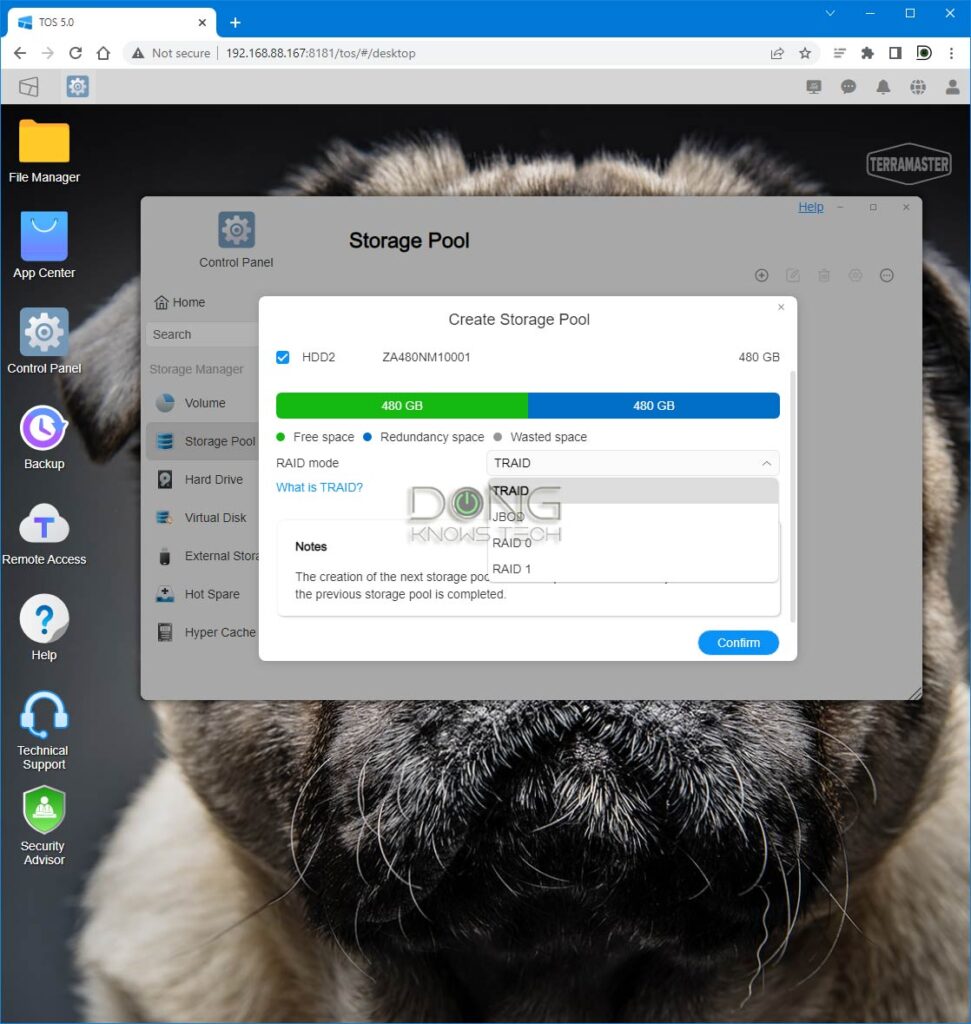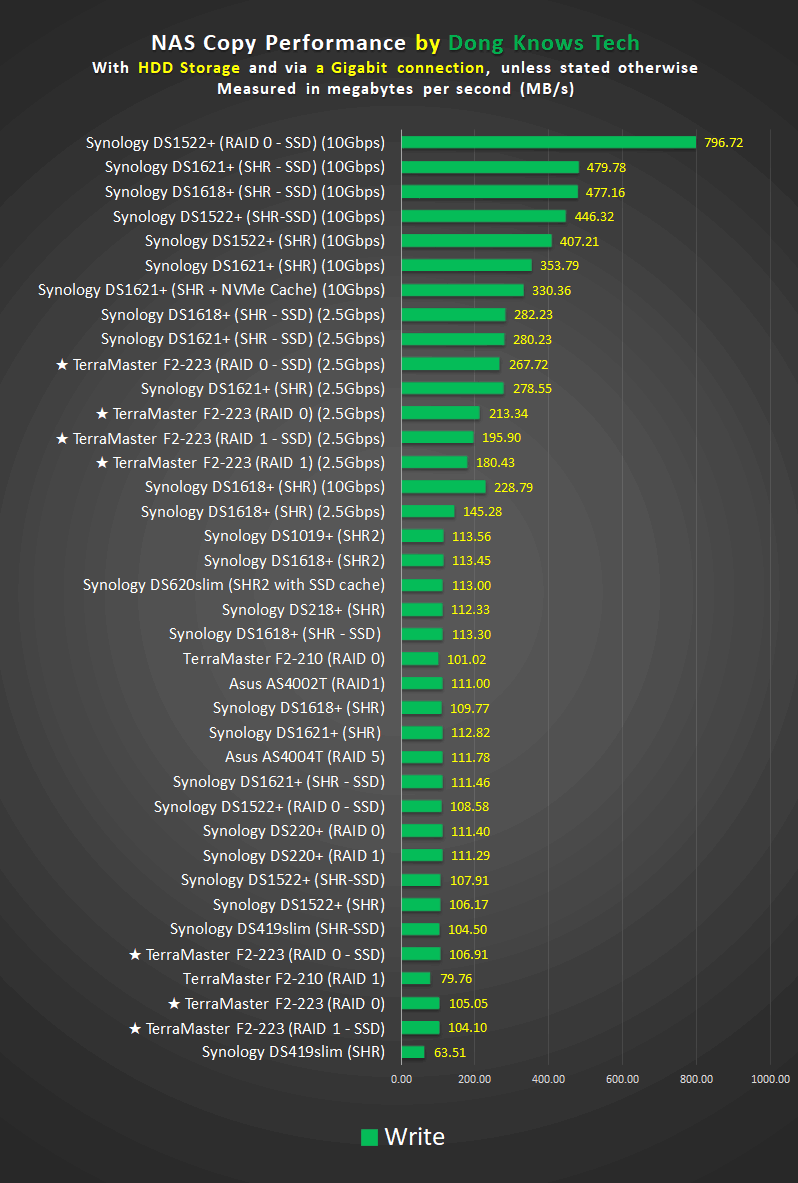When it comes to NAS servers, I’ve always recommended Synology. But once in a while, it’s worth checkout other brands, too. So here goes: The TerraMaster F2-223.
This new server is TerraMaster’s major release in its 2-bay entry-level lineup with native support for Multi-Gig and the latest TerraMaster Operating System (TOS) version 5.
It has much to offer over the previous models and proved much faster than the Synology DS220+ counterpart. But it’s far from perfect.
Here’s the bottom line: If you’re looking for an affordable Multi-Gig-ready server with a fast raw performance at the current street price of $300 (disk-less), the F2-223 will make an excellent first NAS device for those wanting to dabble into the world of serious network storage.
If you want deep functionality and a more refined experience, I’d still recommend the similarly-priced but Gigabit-only DS220+ or a higher-end Synology server.


TerraMaster F2-223: A major hardware upgrade in a familiar design
As mentioned above, the F2-223 is the latest in TerraMaster’s 2-day product line. It natively runs TerraMaster Operating System (TOS) 5 and is the first with two Multi-Gig 2.5Gbps ports. Previous models, the F2-221, F2-220, and original F2-210, all use Gigabit.
All previous models use TOS 4 and can be upgraded to TOS 5, except the F2-210, which is stuck at TOS 4.1.32.
So hardware-wise, the TerraMaster F2-223 is significant. The Synology DS220+ and most Synology servers have Gigabit by default, and only some allow for Ethernet upgrade.
Tool-less drive bay design
The TerraMaster F2-223 NAS server shares the same hardware design as previous models. It looks the same as the F2-210, as in the photos.
As such, it’s comparatively bulky for a dual-bay server- much larger than two standard 3.5-inch hardware put together- with a protruding back to hold a large ventilation fan. But it’s compact enough.
Besides the two Multi-Gig ports, the F2-223 also has two USB 3.0 ports to host extra storage and an HDMI port for direct media streaming, which is more of a gimmick (often found in QNAP servers) than a real feature.


Unlike the F2-210, which requires a screwdriver for hard drive installation, the F2-223 comes with drive trays — similar to those of Synology — that allow for toolless hard drive (HDD) installation and removal. You only need to use a screwdriver when installing 2.5-inch (laptop) HDDs or solid-state drives (SSDs).
Once you’ve assumed a drive onto the tray, push it into the server, and the tray will stay put. Note, though, that each has no security lock against accidental out-pulling like the case of the Synology server.
Installing the drives is the only hard work in getting the new server up and running. Now plug the server into the network, power it on, and you’re almost ready.
The simple software setup process
To make the server work, you’d first need to install the operating system, TOS 5, on it — a simple process.

First, download and install the TNAS PC software — there are Windows, macOS, and Linux versions — on a computer and run it.
After a few seconds, the software will find the server in the network. Now you can use its IP address on a browser or click on the software’s login button, to launch the initial web-based setup wizard.
The wizard will work through self-explanatory steps to install the OS — directly from TerraMaster’s server or via a local file — and everything else, including picking the RAID configurations, file format (BTRFS or EXT4), and the first user account.
The process will take five to 30 minutes, depending on your Internet speed. And then, you can log in to the server’s web interface — via the same IP address — to further customize it.


TerraMaster F2-223: Hardware specifications
| CPU | Intel Celeron N4505 64-bit Quad Core 2.0 GHz (Max burst up to 2.9 GHz) |
| Hardware encryption engine | Yes |
| Memory | 4GB (Upgradeable to 32GB via two slots) |
| Compatible drive type | 2 x 3.5″ or 2.5” SATA HDDs/SSDs (drives not included) |
| Hot-swappable drive | Yes |
| External port | 2 x USB 3.0 ports |
| Size (HxWxD) | 8.93 x 4.68 x 5.23 in (227 x 119 x 133 mm) |
| Weight | 5.2 lbs (2.4 kg) |
| Network Ports | 2 x 2.5GbE (Multi-Gig) |
| Wake on LAN/WAN | Yes |
| Scheduled power on/off | Yes |
| File Protocols | SAMBA/AFP/NFS/FTP/WebDAV |
| AC Input | 100V to 240V AC |
| Power Consumption (per 24 hours) |
≈ 490 Wh (as tested with two hard drives) |
| Maximum storage capacity | 40TB (2 x 20TB drives) |
| Maximum local user accounts | 2048 |
| Maximum share folders | 512 |
| Supported RAID type | Single, JBOD, RAID 0, RAID 1, TRAID |
| Suggested retail price (disk-less) | $300 |
| Warranty | 2 years |
Robust web interface, TRAID support, and some useful apps
TerraMaster’s TOS 5 is very similar to Synology DSM and resembles the UI of a native operating system.
You can run multiple apps simultaneously and use the Control Panel to configure the router. Most importantly, there’s the app store called App Center that allows for installing more apps on the server.

But first, it’s worth noting that TOS 5 now has a flexible RAID setup called TRAID, which shares the same idea as Synology’s Hybrid RAID (SHR). TRAID allows for mixing drives of different capacities, easy storage scale-up, and automatic RAID function.
In the case of the F2-223, TRAID is similar to RAID 1. To take full advantage of TRAID, you need to use a server for more drive bays. In any case, the support for TRAID shortens the gap that TerraMaster trails behind Synology considerably.
And apps are where TOS is much behind DSM. There are only 55 apps (44 if you take out the Betas), and only a few are useful. The rest are mostly irrelevant to home users and the TerraMaster, for now, has no app for business users.
But TOS 5 now does have domain/LDAP integration allowing the server to work as part of a business environment with a domain controller. While inapplicable to home users, this feature is a must-have any many businesses.

What’s also significant is the support for the BRTFS files system and the Snapshot feature, which enables the keeping of versions by shared folders to fight against accidental deletions or alterations.
Other than that, a few noticeable apps on the server include:
- Transmission: An app for download, similar to the Download Station of Synology. This app is now much better and allows users to search and download stuff from the Internet easily. It will work on a separate tab, not as a window within the server’s main UI.
- Multimedia Server: A server app for streaming content hosted on the F2-223, similar to the Media Station of Synology. TerraMaster doesn’t have playback apps on the front end, but Multimedia Sever supports standard streaming protocols — you can use third-party streamers with it. On top of that, the server also has a beta version of Plex and Emby — two popular streaming platforms.
- TerraSync: including Server and Client apps, TerraSync is a copy of Synology Drive that allows syncing and baking data of multiple clients.

I tried these apps out briefly, and they worked as intended. However, none has the same level of in-depth customization for functionality as the Synology counterparts. Hopefully, things will change via future versions.
TerraMaster F2-223: Detal photos





TerraMaster F2-223: Fast performance
I used the TerraMaster F2-223 for over a week, and the server worked well as intended at all times with no hiccups.


For throughput performance, I tested it with two 8TB hard drives and two SSDs, in RAID 1 and RAID 0. It’s important to note that you should use the server in RAID 1 or TRAID since RAID 0 offers no data protection.
Thanks to the 2.5Gbe ports, the TerraMaster F2-223 excelled in my testing. I generally maxed out the speed of the test wired connection, be it 2.5Gbps or Gigabit.
The server remained cool and quiet, even when it used a hard drive on the inside. Its fan did work most of the time but only produced a low humming sound.
Pros
Two built-in 2.5Gbps Multi-gig ports; fast performance
TOS 5 with lots of improvement, including domain/LDAP integration, robust interface, TRAID, Snapshot, and more
Cros
TOS 5 and most apps seem not mature enough
Conclusion
Thanks to the new operating system and two 2.5Gbps ports, the TerraMaster F2-223 is an excellent buy for those wanting an affordable yet fast NAS server. Just make sure you have a Multi-gig switch for it.
While TerraMaster doesn’t offer a similar level of depth in its software as Synology, for general home use, chances are the F2-223 has enough, and potentially things will only get better via future updates.
Most importantly, the TerraMaster F2-223 is currently the only $300 option on the market that gives you Mult-Gig performance right out of the box. And I know that alone will make a lot of folks happy. So if you want to get serious about home network storage, get one today!
